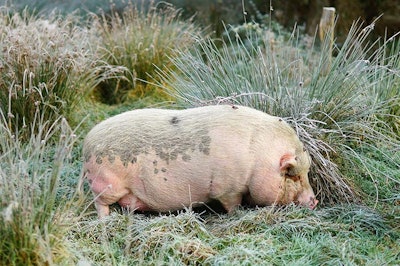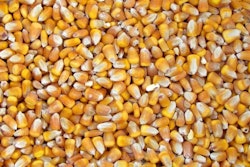
Outdoor pig production on a large scale is gaining a foothold, especially for new hog producers looking to get started in the industry. Benefits of raising pigs on pasture include improved pig health, a better work environment, less odor, less microbial activity, fewer regulatory problems and lower start-up and operating costs, according to research by Texas Tech University’s Sustainable Pork Program.
“This market for this kind of pork is huge; it’s untapped,” said Steve Deibele, who owns Golden Bear Farm, a certified organic farm that produces grass-fed beef and pastured hogs. "The problem with that is that it’s also undeveloped. When you look at doing this kind of pork production, it’s not what you can produce that counts, it’s what you can actually sell and make money with."
Deibele shared tips for efficient and profitable pasture operations during a presentation on organic, pastured pork production at the Midwest Organic and Sustainable Education Service (MOSES) Organic Farming Conference in La Crosse, Wisconsin, on February 24, 2017.
“Our strategies as a farm have been to mimic nature. We’re trying to do it in a scientific fashion, systematically,” he explained.
A grazing plan that works
The main cost in any hog system is feed, including on pastured operations with supplemental feed. In a pastured operation, you can expect to have some of the grains replaced by forage, said Deibele; conservatively, if you’re feeding a lot of forage, you should be able to expect a 10 percent reduction in required grain. If you’re really managing tightly, you can be looking at a 20 to 50 percent grain reduction in a well-managed feeder hog up to market weight.
“The more you keep the pigs moving, the better.”
“The mantra is, keep your pigs moving. When they are moving, they are focused more on eating,” said Deibele. This can be done even on relatively small acreage. For example, Deibele explained, with five acres, think of it as five single-acre parcels. In the first strip, graze the hogs for 15 days. Decide if you’re going to give them the whole slot at once or split it into three parcels, as you have the flexibility to do so. On days 16 to 30, move the hogs to the second strip. Immediately after the hogs are pulled off the first strip, begin repair or renovation of the first strip, and do it immediately so it’s back into the production game. On day 30 or 31, move the hogs to the third pasture. Keep walking around the field in this way.
“The more you keep the pigs moving, the better,” again emphasized Deibele. “However, if you have really wet conditions, where the ground is extremely vulnerable — get them off, get them back to the barn.” They can always be fed forage in the barn. “In all cases of livestock management, you want to monitor what they are eating and regularly make adjustments so you are not wasting or underfeeding,” he added.
And most of all, make sure your pastures have something attractive to eat, and lots of variety. “Pigs want variety, just like people do,” said Deibele. For hog feeders on pastures, Deibele recommends troughs laid out so that all pigs can eat at the same time, including some self-feeders. For large numbers of hogs, Deibele provides up to two-thirds of the daily feed in the troughs in the morning and the rest an hour or two before dusk to continually encourage feeding. As for water, Deibele recommends one nipple waterer for every 8 to 12 pigs in a pasture setting.
How to motivate better growth rates on the pasture
“The first thing I recommend is to extend the day for the hogs. Get them up early and have them start eating,” said Deibele. Lay out feed if necessary in the trough to get all of the pigs up to eat. He also recommends spending time in the pasture interacting with the hogs, as it encourages them to get up and move and lets you inspect the animals. “We’ve experienced a growth rate difference of .3 to .5 pounds per pig, per day by doing this.”
Deibele also encourages producers to work with a pig’s psychology to reduce herd competition, which can affect growth rates. This can happen two ways. First, feed them a couple times a day on pasture with sufficient trough space. Second, mimic a pig’s natural family life within a herd. In nature, pigs live as families with other pigs of different sizes and ages. Production settings have pigs that are all the same size and age, which causes stress in the group and often creates fighting and squabbles. Deibele recommends mixing up the group by choosing older, non-timid and experienced hogs to mix in with the younger pigs.
Careful attention to pasture conditions is what makes this work.
Stimulating pigs on pasture can also be as simple as putting clean, plastic bottles in the field for them to play with. Most importantly, however, is keeping them comfortable under all field conditions. Careful attention to pasture conditions is what makes this work.
Aiming for quality and profit
“We will never get to the point where we can complete dollar for dollar with conventional pork production, but our advantage is in the quality of what we’re producing, and the overall value,” said Deibele. The range of price for pork produced on Golden Bear Farm is USD$6.50 a pound per packaged meat, and USD$9.50 to USD$11 a pound for retail. Some stores sell his bacon at USD$13 a pound, he said. His estimated cost per pound to raise a hog is almost 90 cents a pound. He is working at reducing that to 70 cents a pound. Smaller pigs cost him about 55 cents a pound. These numbers, he joked, do not include his time and labor.
“The three biggest reasons we raise our hogs on pasture are trying to improve the nutritional value and taste of the meat products, trying to provide better welfare and trying to create farm synergy with our operations, in any way we can,” said Deibele.

















